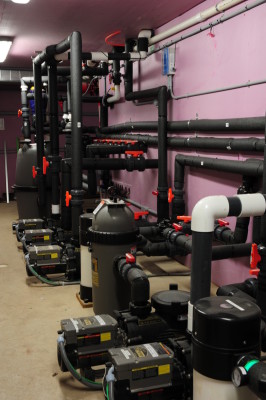The heat is on
The spa’s heating system will depend on the available fuel source. Heating options include fossil fuel heaters, which offer the ability to quickly increase the water’s temperature and heat pumps, which are effective at maintaining a constant temperature.
Geothermal heating systems, combined with heat exchangers, can also be a cost-effective solution for areas without access to natural gas. Electric heaters are another option. These heaters are used on most portable spa designs; however, they are equally effective for smaller concrete spas.
Spa owners who like the natural feeling of stoking the fire in return for hot water can also use wood-fired heat exchangers.
Energy-efficient techniques
The green revolution has had a major impact on spa design. In terms of circulation and jet pumps, variable-drive or two-speed pumps should be the minimum standard for their energy-saving potential.

Furthermore, to minimize heat loss in the spa and reduce electricity consumption, the spa’s shell should be insulated. The greater the temperature difference is between the spa water and the outside environment, the more practical and beneficial the insulation becomes. Insulating all of the plumbing lines associated with the spa (or at least the return line from the heater) can help reduce operating costs for the owner.
The most cost-effective method for increasing a spa’s energy efficiency is to use a spa cover. A cover will minimize heat loss due to evaporation, without it all other insulation is essentially wasted.
A cover can be as simple as a small solar blanker or as complex as a custom-engineered automated design. Its size and weight is determined by the spa’s size. Lifting devices may be required to assist with the installation of large, heavy covers.
Not all spas are alike
Most custom projects installed by spa builders are never one in the same. Each design takes a variety of factors into consideration—from individual client needs to specific site requirements. By thinking outside the standard design ‘box,’ spa builders will see an increase in profits, as well as achieve the ‘wow’ factor their clients are seeking.
 Barry Justus is the owner of Poolscape Inc., a landscape contractor and pool designing and building company based in Burlington, Ont. He can be reached at barry@poolscape.com or by visiting www.poolscape.com.
Barry Justus is the owner of Poolscape Inc., a landscape contractor and pool designing and building company based in Burlington, Ont. He can be reached at barry@poolscape.com or by visiting www.poolscape.com.







